
Burmanniaceae is a family of flowering plants, consisting of 99 species of herbaceous plants in eight genera.

Hexalectris is a genus of the family Orchidaceae, comprising 10 known species of fully myco-heterotrophic orchids. These species are found in North America, with the center of diversity in northern Mexico. None of the species are particularly common. Hexalectris spicata has a wide distribution and is likely the most abundant member of the genus, but is nevertheless infrequent throughout its range. Other species are rare, and some, such as H. colemanii, are threatened or endangered. All species that have been studied form associations with ectomycorrhizal fungi that are likely linked to surrounding trees. Many Hexalectris species are found in association with oak trees (Quercus), which are ectomycorrhizal.

Galeola is a genus of orchids belonging to the subfamily Vanilloideae.

Corallorhiza maculata, or spotted coralroot, is a North American coralroot orchid. It has three varieties: C. maculata var. occidentalis, C. maculata var. maculata, and C. maculata var. mexicana. It is widespread through Mexico, Guatemala, Canada, St. Pierre & Miquelon, and much of the western and northern United States. It grows mostly in montane woodlands.
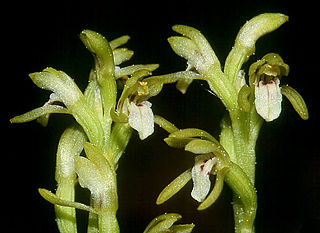
Corallorhiza, the coralroot, is a genus of flowering plants in the orchid family. Except for the circumboreal C. trifida, the genus is restricted to North America.
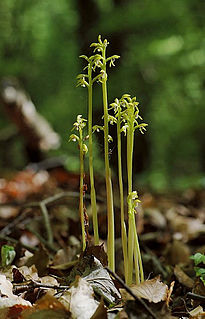
Corallorhiza trifida, commonly known as early coralroot, northern coralroot, or yellow coralroot, is a coralroot orchid native to North America and Eurasia, with a circumboreal distribution. The species has been reported from the United States, Canada, Russia, China, Japan, Korea, India, Nepal, Kashmir, Greenland, Pakistan, and almost every country in Europe.
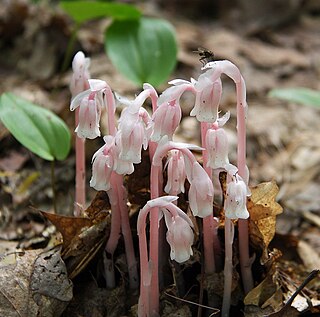
Myco-heterotrophy is a symbiotic relationship between certain kinds of plants and fungi, in which the plant gets all or part of its food from parasitism upon fungi rather than from photosynthesis. A myco-heterotroph is the parasitic plant partner in this relationship. Myco-heterotrophy is considered a kind of cheating relationship and myco-heterotrophs are sometimes informally referred to as "mycorrhizal cheaters". This relationship is sometimes referred to as mycotrophy, though this term is also used for plants that engage in mutualistic mycorrhizal relationships.
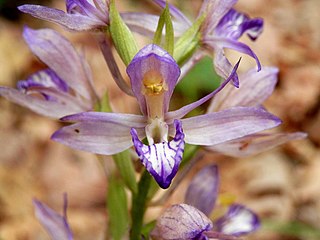
Limodorum abortivum, also known as Violet Limodore or Violet bird's-nest orchid, is a species of myco-heterotrophic, achlorophyllous orchid and is native to mainland Europe, western Asia and the Mediterranean area.
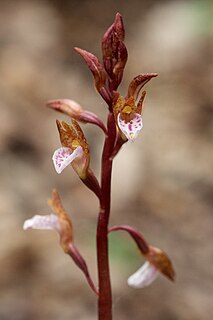
Corallorhiza wisteriana, the spring coralroot, arousing coralroot or Wister's coralroot, is a species of coralroot orchid. It is widespread through much of Mexico as well as parts of the United States.

Corallorhiza mertensiana, or Pacific coralroot, is a coralroot orchid native to the shady conifer forests of northwestern North America. It also goes by the common names Western coralroot and Mertens' coralroot. Corallorhiza mertensiana was previously considered a subspecies of Corallorhiza maculata but was given species rank in 1997 by Freudenstein.
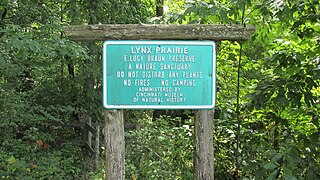
Lynx Prairie is a 52-acre (210,000 m2) nature preserve located in Adams County, Ohio, United States, near the community of Lynx. The preserve features a group of cedar glades which harbor rare prairie species, surrounded by forests on all sides.
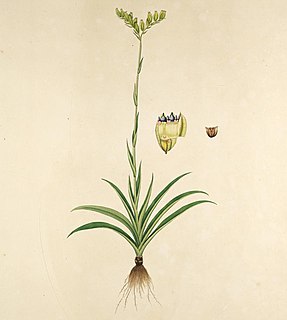
Burmannia is a genus of flowering plants long thought of as related to orchids, although more recent studies suggest closer affinities with either the Dioscoreales or the Melanthiales. The plants are herbs, partially autotrophic (photosynthetic) but also partially parasitic on soil fungi.
Hexalectris arizonica, the spiked crested coralroot or Arizona crested coralroot, is a terrestrial, myco-heterotrophic orchid lacking chlorophyll and subsisting entirely on nutrients obtained from mycorrhizal fungi in the soil. It is native to Arizona, New Mexico, Texas and Coahuila. It is closely related to H. spicata and sometimes regarded as a variety of that species.

Hexalectris spicata, the spiked crested coralroot, is a terrestrial, myco-heterotrophic orchid lacking chlorophyll and subsisting entirely on nutrients obtained from mycorrhizal fungi in the soil. It is native to Arizona, New Mexico, Texas and Coahuila. It is closely related to H. arizonica and the two are sometimes considered varieties of the same species. Hexalectris spicata is endemic to the southern half of the United States from Arizona east to Florida and north to Maryland and the Ohio Valley.
Hexalectris grandiflora, the largeflower crested coralroot or giant coral-root, is a species of orchid native to Mexico from Chihuahua south to Oaxaca, as well as to western and north-central Texas. It is a myco-heterotrophic species, lacking chlorophyll and subsisting entirely on nutrients obtained by fungi in the soil.
Hexalectris colemanii, or Coleman's crested coralroot, is a terrestrial, myco-heterotrophic orchid lacking chlorophyll and subsisting entirely on nutrients obtained from mycorrhizal fungi in the soil. It is a very rare species endemic to southern Arizona, known from only three counties. It is closely related to H. revoluta and the two are sometimes considered varieties of the same species.
Hexalectris revoluta, the Chisos Mountain crested coralroot, is a terrestrial, myco-heterotrophic orchid lacking chlorophyll and subsisting entirely on nutrients obtained from mycorrhizal fungi in the soil. It is closely related to H. colemanii; the two are regarded by some authors as varieties of the same species. Hexalectris revoluta is native to western Texas, southeastern New Mexico and Chihuahua.
Vietorchis is a genus of myco-heterotrophic flowering plants in the orchid family, Orchidaceae. It contains only one known species, Vietorchis aurea, endemic to northern Vietnam.
Spiked crested coralroot is a common name for two plants which are sometimes considered to belong to the same species:












